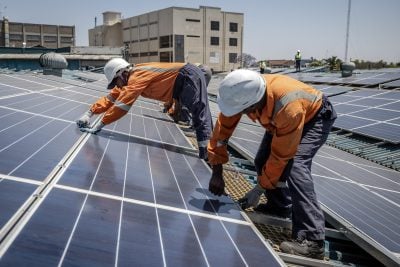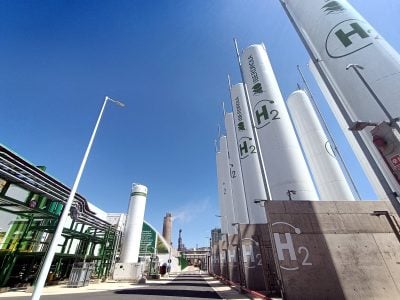Africa may not be the first continent that springs to mind when thinking about smog-cloaked cities. But that could change, if urban centres grow as fast as forecast without sufficient checks on pollution or traffic. The continent’s urban population could grow by more than half a billion people by 2040. That would represent a higher rate of growth than seen in China’s urban centres over two decades of economic growth there, with all the same associated risks, according to the International Energy Agency.
The process has already started. Researchers at the University of Birmingham in the UK reported in April 2020 that particulate matter pollution levels in Nairobi, Kampala and Addis Ababa have increased by 182%, 162% and 62% respectively between the 1970s and the current period. The research was based on visibility data, as direct air quality monitoring has been limited in Africa.
“Evidence indicates that ambient air quality in urban African locations is often poor, because of high rates of urbanisation and population growth leading to large-scale construction, increased energy use, vehicle emissions and industrialisation,” Ajit Singh, one of the report’s authors, said on its publication.
Poor air quality acted as a brake on development through increasing expenditure on health, loss of labour productivity, and the impact of illness on education, the researchers said.
Kenyan-registered NGO Sustainable Transport Africa has noted the unequal impact of urban pollution on different areas of the population. It is the urban poor that tend to suffer most, because they often live or work in the most polluted areas, contract pollution-related diseases that hinder their ability to earn a living, and are the least able to meet healthcare costs. They are also the people least likely to own their own vehicle, so they feel the largest negative impacts from transport pollution, while not benefiting much from the transport itself.
However, with the biggest phase of Africa’s urbanisation still to come, countries have the opportunity to implement lessons learned the hard way in other parts of the world and take measures to ensure that next stage happens in a healthier and more sustainable way.
Cleaner air, reliable supply
The speed and somewhat piecemeal way in which many large African cities with populations larger than 100,000 have sprung up create problems in terms of power provision. Many homes and businesses are not connected to reliable national or regional grid supply, leaving inhabitants reliant on polluting diesel generators.
Mini grids are proving to be an important part of the solution in some parts of the continent. Not only does the energy they provide displace dirtier diesel generation, they are also relatively cheap and rapid to install compared to national grid connections. Their restricted size can also be an advantage in cities where the planning process for larger-scale electrification can get bogged down in red tape.
While the regulatory environment in some African countries remains difficult for developers of these smaller-scale projects, some have been more accommodating.
Nigeria’s Energising Economies Initiative (EEI), set up under the Rural Electrification Agency, has aimed to maximise the benefits of this approach by launching a programme to bring energy access to 100,000 establishments in economic centres, such as the country’s myriad markets and shopping complexes, as well as agricultural and industrial clusters.
Millions of people who work in or use these centres will reap the benefit. Seventy percent of the power is intended to come from renewable sources, but even where it doesn’t, supply from a local power station will be cleaner than thousands of inefficient diesel generators.
These are independent power producer (IPP) projects so they have also provided an opportunity for private sector startups. For example, in Lagos – where the main problem is erratic grid supply – Solad Power Holdings has developed a 1.5 MW off-grid power system for Sura Shopping Complex.
More than 1,000 shops, mainly mid-scale manufacturing and distribution companies, can now benefit from a stable power supply, which uses excess electricity from the Lagos Island power plant via a 2km distribution network. The unit cost of power is higher than before the IPP supply was introduced in 2018, but smart metering and reliability – which cuts diesel costs – has generally made it popular among those with the greatest electricity needs.
Another example is the 9.5 MW gas-fuelled off-grid power system built by private investors to supply up to 47,000 shops and small businesses operating at the Ariaria International Market in Aba, Abia State, which was commissioned in January 2019.
Growing investor interest in the sector is illustrated by the ability of Nigerian start-up Rensource Energy to raise $20m to invest in projects to power urban markets. The company provides power via solar panels, batteries and a power management system, backed up by its own diesel backup generation. The company is already using this model for the Sabon Gari Market mini-grid project in Kano, providing power to over 11,000 shops via solar panels spread across the roofs of the market.
Street smart
Cleaning up Africa’s growing vehicle fleet – the other major cause of urban pollution – is an even more complex problem, but one which is starting to be tackled. Uganda and Rwanda are among countries developing electric vehicle manufacturing capacity.
But no one expects African drivers to be switching in their droves to electric cars anytime soon. High cost, poor power infrastructure and limited distribution are likely to prove prohibitive for mass-market uptake across much of the continent for the foreseeable future.
However, improved public transport does offer opportunities to reduce urban pollution by offering a cleaner-running alternative to existing vehicles.
Egypt recently introduced its first electric buses – made in China – on a 25km route in Cairo. The government recently signed an agreement with Chinese manufacturer Foton Motor to build 2,000 electric buses over four years in Egypt with production scheduled to start in late 2020. It also signed an agreement with another Chinese company, Geely, to manufacture electric cars.
In 2016, Uganda’s state-owned Kiira Motors Corporation even unveiled a solar electric bus built in partnership with a Chinese firm, powered by solar panels in the roof. It has also produced a more conventional battery powered bus.
Buses don’t have to be electric to make a difference, of course. A well-planned public transport system reduces pollution – and congestion – by taking other vehicles off urban roads.
Cheaper and easier to implement than metro systems in many cities, bus-based rapid transit systems are catching on. In this respect, Dar es Salaam, Tanzania’s commercial hub and home to 6m people, is often cited an example of what can be achieved.
Launched in 2016, the city’s six-phase Dart rapid transit bus system is now entering its third phase. The project has involved hiving off dedicated lanes on existing roads for buses and on its completion some 137km of new roads will have been built, according to the plan.
By separating out the buses from the rest of Dar’s clogged traffic lanes, the Dart has more than halved the journey time on some of the longer commutes in the city.
But not everyone’s a fan. These projects are backed by assistance from the World Bank Group and other development institutions – money which some say could be better spent better elsewhere. The Dart, for instance, is not used by the poorest citizens, who use the cheaper traditional daladala minibuses and still have to endure gridlock on their journeys to work.
There are also concerns about how the system will be financed if development assistance goes elsewhere. Few metropolitan public transport systems ever become totally self-supporting and the Dart is likely to be no exception – in the long run it will require public money to survive.
Nevertheless, the Dart is an example of a project whose implementation has tangibly improved the lives of Tanzanians and shows that swiftly taken action can help shape city life for the better.
Want to continue reading? Subscribe today.
You've read all your free articles for this month! Subscribe now to enjoy full access to our content.
Digital Monthly
£8.00 / month
Receive full unlimited access to our articles, opinions, podcasts and more.
Digital Yearly
£70.00 / year
Our best value offer - save £26 and gain access to all of our digital content for an entire year!
 Sign in with Google
Sign in with Google 



